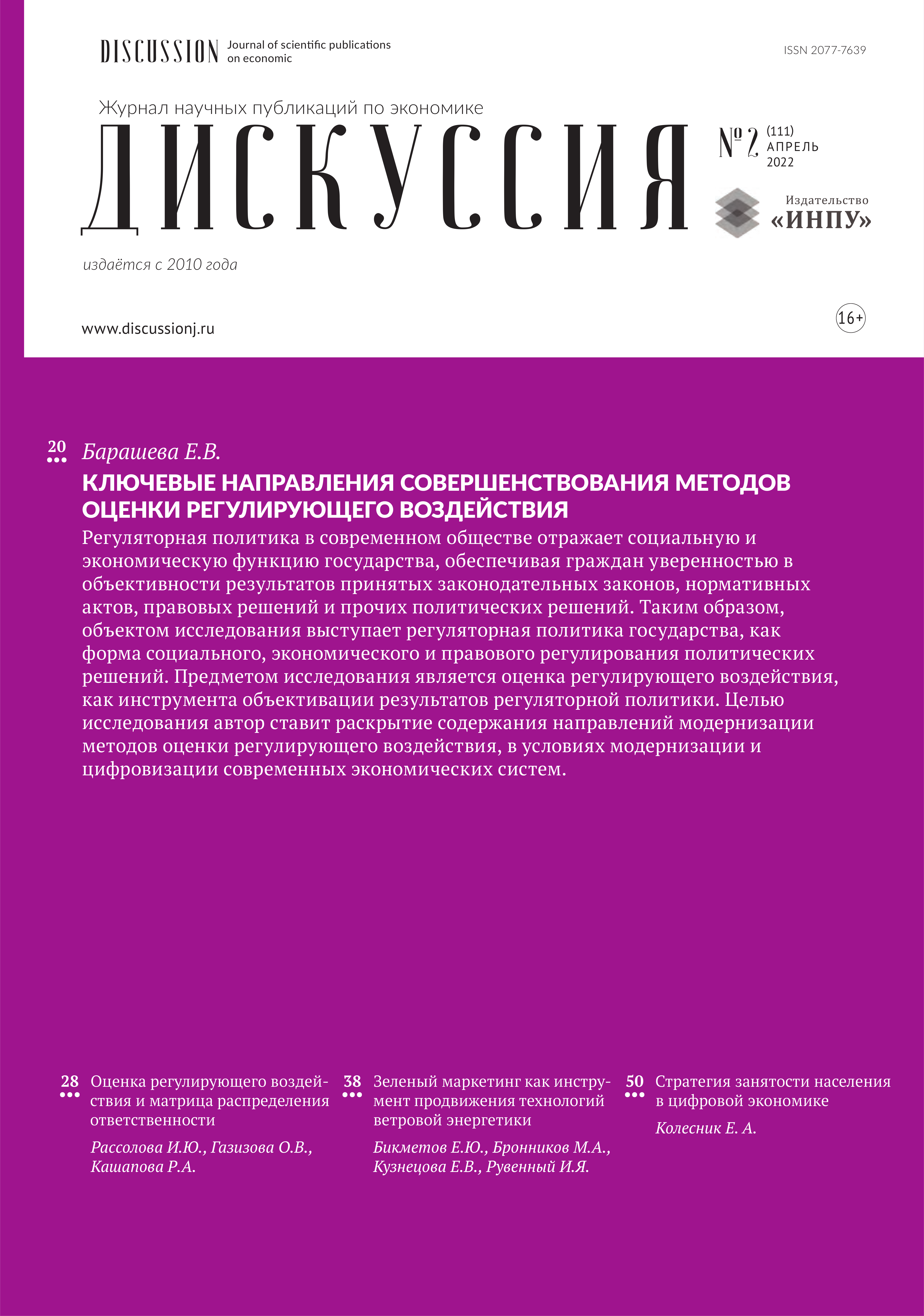Green marketing as a tool for promoting wind energy technologies
Keywords:
Green technologies, green marketing, wind energy, wind power plants, energy efficiencyAbstract
Currently, one of the urgent problems is environmental sustainability, the absence of which can lead to a deterioration in the living conditions of future generations of people. To ensure environmental sustainability, it is necessary not only to improve production technologies, but also the use of green (environmental) marketing. The purpose of this marketing is to focus the market on products produced using environmentally friendly technologies. One of the promising green technologies is wind energy, which does not pollute the air, does not affect the climate and is mobile. The article considers the need for active use of marketing of green technologies in the field of wind energy and analyzes the development of alternative technological solutions in this area. The object of the study is wind energy as an energy industry that provides resistant ecosystem homeostasis and environmental sustainability; the subject of the study is green marketing within the framework of the concept of sustainable development. The advantages of using green marketing by wind energy enterprises are the focus on developing the brand image and reputation of the manufacturer; the implementation of corporate social responsibility in the field of energy conservation; increasing competitive advantages in the market; increasing the profitability of production and operation. The classification of wind power plants (wind turbines) according to the orientation of the wind-receiving rotor is given. The operation of horizontal axis and vertical axis wind power plants is compared. Alternative technical solutions in wind turbine constructions using modern knowledge in the field of composite materials and mathematical modeling methods are presented. It is shown that increasing energy efficiency is a key factor in ensuring the profitability of the use of wind turbines. The main trends in the development of wind power plants, both highpower wind farms and small local wind turbines have been identified. Marketing management, which can be implemented through the cooperation of technology startups and the state on the principles of mutually beneficial partnerships, is the instrument for successful product launch into the green energy market in modern conditions.
Downloads
Metrics
References
E. Bikmetov, N. Galimullina, I. Ruvenny, Z. Sizonenko, R. Sizonenko, “Strategic thinking as a factor of sustainable development of the organization,” E3S Web of Conferences, 208, 2020, 07008.
M. J. Polonsky, P. J. Rosenberg, “Reevaluating green marketing: a strategic approach,” Business Horizons, vol. 44, No. 5, 2001, pp. 21–30.
Peattie K. (2001), Towards sustainability: the third age of marketing, The Marketing Review, Vol. 2, pp. 129-146.
T. Paiva “Green Marketing,” in Encyclopedia of Sustainable Management, S. Idowu, R. Schmidpeter, N. Capaldi, L. Zu, M. Del Baldo, R. Abreu, Eds. Springer, Cham, 2020.
Charter M. (1992), Greener Marketing: A Greener Marketing Approach to Business, Greenleaf Publishing, Sheffield.
H. Simula, T. Lehtimäki, J. Salo, “Managing greenness in technology marketing,” Journal of Systems and Information Technology, 11(4), 2009, pp. 331–346.
X. Wang, S.-H. Cho, A. Scheller-Wolf, “Green technology development and adoption: competition, regulation, and uncertainty – a global game approach,” Management Science, 67(1), 2020, pp. 201–219.
M. El-Samanoudy, A. A. E. Ghorab, Sh. Z. Youssef, “Effect of some design parameters on the performance of a Giromill vertical axis wind turbine,” Ain Shams Engineering Journal, 1, 2010, pp. 85–95.
K. Pope, I. Dincer, G. F. Naterer, “Energy and exergy efficiency comparison of horizontal and vertical axis wind turbines,” Renewable Energy, 35(9), 2010, pp. 2102–2113.
A. Shires, “Design optimisation of an offshore vertical axis wind turbine,” Energy, 166(EN1), 2013, pp. 7–18.
P. Gulve, Sh. Bh. Barve, “Design and construction of vertical axis wind turbine,” International Journal of Mechanical Engineering and Technology (IJMET), 5(10), 2014, pp. 148–155.
K-Y. Lee, S-H. Tsao, Ch.-W. Tzeng, H.-J. Lin, “Influence of the vertical wind and wind direction on the power output of a small vertical-axis wind turbine installed on the rooftop of a building,” Applied Energy, 209(C), 2018, pp. 383–391.
W. Tjiu, T. Marnoto, M. Sohif, M. H. Ruslan, “Darrieus vertical axis wind turbine for power generation I: assessment of Darrieus VAWT configurations,” Renewable Energy, 75, 2015, pp. 50–67.
W. Tjiu, T. Marnoto, M. Sohif, M.H. Ruslan, “Darrieus vertical axis wind turbine for power generation II: challenges in HAWT and the opportunity of multi-megawatt Darrieus VAWT development,” Renewable Energy, 75, 2015, pp. 560–571.
J. Xin, Zh. Gaoyuan, G. KeJun, Ju Wenbin, “Darrieus vertical axis wind turbine: basic research methods,” Renewable and Sustainable Energy Reviews, 42, 2015, pp. 212–225.
M. Shaheen, Sh. Abdallah, “Development of efficient vertical axis wind turbine clustered farms,” Renewable and Sustainable Energy Reviews, 63, 2016, pp. 237–244.
D. Mohamed, A. Zeroual, R. Rabehi, N. Allam, “Wind energy systems: Analysis of the self-starting physics of vertical axis wind turbine,” Renewable and Sustainable Energy Reviews, 81(1), 2017, pp. 1602–1610.
C. M. Vivek, P. Gopikrishnan, R. Murugesh, R. Raja Mohamed, “A review on vertical and horizontal axis wind turbine,” International Research Journal of Engineering and Technology (IRJET), 04(04), 2017, pp. 247–250.
R. Dommeti, A. Kathi, M. Pasumarthi, “A design for high-torque, low-speed vertical axis wind turbine,” in Advances in Smart Grid and Renewable Energy, S. SenGupta et al., Eds. Springer Nature Singapore Pte. Ltd., 2018, pp. 203–213.
R. Kumar, K. Raahemifar, A. S. Fung, “A critical review of vertical axis wind turbines for urban applications,” Renewable and Sustainable Energy Reviews, 89(C), 2018, pp. 281–291.
B. Govind, “Increasing the operational capability of a horizontal axis wind turbine by its integration with a vertical axis wind turbine,” Applied Energy, 199, 2017, pp. 479–494.
S. R. Shah, R. Kumar, K. Raahemifar, A. S. Fung, “Design, modeling and economic performance of a vertical axis wind turbine,” Energy Reports, 4, 2018, pp. 619–623.
M. Moghimi, H. Motawej, “Developed DMST model for performance analysis and parametric evaluation of Gorlov vertical axis wind turbines,” Sustainable Energy Technologies and Assessments, 37, 2020, p. 100616.
B. Hand, A. Cashman, “A review on the historical development of the lift-type vertical axis wind turbine: from onshore to offshore floating application,” Sustainable Energy Technologies and Assessments, 38, 2020, p. 100646.
A. S. Pustovojtov, M. A. CHernov, D. O. Pavlov, L. O. Zemlyanskij, N. V. Aleksandrov, “Obzor razlichnyh tipov vetrogeneratorov, ispol'zuyushchihsya v mire,” Evrazijskoe nauchnoe ob"edinenie, 9-2(67), 2020, s. 124–127, (in Russian).
A. A. Bubenchikov, A. E. Belodedov, I. S. Bulychev, A. O. SHepelev, “Issledovanie aerodinamiki i energeticheskih harakteristik rotora Savoniusa,” Mezhdunarodnyj nauchno-issledovatel'skij zhurnal, 12-3(54), 2016, s. 28–34, (in Russian).
B. P. Hozyainov, “Puti dostizheniya liderstva v vetroenergetike,” Mezhdunarodnyj nauchnyj zhurnal Al'ternativnaya energetika i ekologiya, 22-24(270-272), 2018, s. 59–67, (in Russian).
M. V. Deremov, N. V. Rudenko, V. V. Ershov, G. Z. Mahauri, “Analiz vozmozhnosti ispol'zovaniya vetroenergeticheskih ustanovok dlya elektrosnabzheniya avtonomnyh ob"ektov svyazi Krajnego Severa,” Trudy Severo-kavkazskogo filiala Moskovskogo tekhnicheskogo universiteta svyazi i informatiki, 1, 2019, s. 295–301, (in Russian).
N. D. SHishkin, R. A. Il'in, D. I. Atdaev, “Primenenie ekologicheski effektivnyh vertikal'no-osevyh vetroenergoustanovok dlya zapovednikov i nacional'nyh parkov yuga Rossii,” Ekologiya i promyshlennost' Rossii, T. 23, 11, 2019, s. 43–49, (in Russian).
Ch. Wilson, A. Grubler, K. S. Gallagher, G. F. Nemet, “Marginalization of end-use technologies in energy innovation for climate protection,” Nature climate change, 2, 2012, pp. 780–788.
A. Lindman, P. Söderholm, “Wind energy and green economy in Europe: Measuring policy-induced innovation using patent data,” Applied Energy, 179(C), 2016, pp. 1351–1359.
M. Van Geenhuizen, R. Nejabat, “Municipalities’ policy on innovation and market introduction in sustainable energy: a focus on local young technology firms,” Energies, 14(4), 2021, p. 1094.
Downloads
Published
How to Cite
Issue
Section
Categories
License
Copyright (c) 2022 Е. Ю. Бикметов , М. А. Бронников , Е. В. Кузнецова , И. Я. Рувенный

This work is licensed under a Creative Commons Attribution-NonCommercial-NoDerivatives 4.0 International License.
Авторы, публикующие произведения в журнале «Дискуссия», соглашаются со следующими условиями:
- Авторы сохраняют за собой авторское право и предоставляют журналу право первой публикации произведения, одновременно лицензированной в соответствии с лицензией Creative Commons Attribution, позволяющей другим лицам пользоваться произведением с подтверждением авторства и первоначальной публикации в журнале «Дискуссия».
- Авторы вправе заключать с иными лицами лицензионные договоры на условиях простой (неисключительной) лицензии на использование опубликованного в журнале «Дискуссия» произведения (например, размещение его в базах данных университетов, публикация в книге), со ссылкой на его оригинальную публикацию в этом журнале.
- Автор гарантирует, что является правообладателем всех материалов, предоставляемых в редакцию, и что исключительные права на данные материалы не переданы или не предоставлены другим лицам.
- Авторам разрешено и рекомендуется размещать свое произведение в Интернете до и во время процесса подачи, поскольку это может привести к продуктивному обмену, а также к более раннему и более широкому цитированию опубликованных работ.
С момента загрузки произведения и сопроводительных материалов через раздел "Отправка материалов", автор полностью и безоговорочно принимает (акцептует) публичную оферту о заключении авторского соглашения об опубликовании произведения. В соотвтетствии с этим соглашением автор предоставляет издателю на безвозмездной основе неисключительную лицензию на использование созданного автором произведения.
С момента получения произведения и прилагаемых к нему материалов журнал "Дискуссия" вправе использовать полученные произведения без ограничений по своему усмотрению и в пределах всего срока действия исключительных прав, но с обязательным указанием имени автора (авторов) произведения, в том числе публиковать произведения (полностью или в сокращении) на территории всего мира, переводить на другие языки, направлять в репозитории научной информации, размещать в сети Интернет и использовать другими законными способами.









